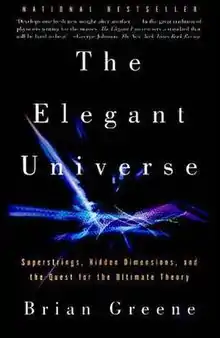 Hardcover edition | |
| Author | Brian Greene |
|---|---|
| Cover artist | Sherry Love |
| Country | United States |
| Language | English |
| Subject | String theory |
| Genre | Non-fiction |
| Publisher | W. W. Norton |
Publication date | 1999/2003 |
| Media type | Print (hardcover and paperback) |
| Pages | 448 pp. (2003 edition) |
| ISBN | 0-393-05858-1 (2003 edition) |
| Followed by | The Fabric of the Cosmos |
The Elegant Universe: Superstrings, Hidden Dimensions, and the Quest for the Ultimate Theory is a book by Brian Greene published in 1999, which introduces string and superstring theory, and provides a comprehensive though non-technical assessment of the theory and some of its shortcomings. In 2000, it won the Royal Society Prize for Science Books and was a finalist for the Pulitzer Prize for General Non-Fiction. A new edition was released in 2003, with an updated preface.
Table of contents
- Preface (with an additional preface to the 2003 edition)
- Part I: The Edge of Knowledge
- Part II: The Dilemma of Space, Time, and the Quanta
- Part III: The Cosmic Symphony
- Part IV: String Theory and the Fabric of Spacetime
- Part V: Unification in the Twenty-First Century
Contents
Beginning with a brief consideration of classical physics, which concentrates on the major conflicts in physics, Greene establishes a historical context for string theory as a necessary means of integrating the probabilistic world of the standard model of particle physics and the deterministic Newtonian physics of the macroscopic world. Greene discusses the essential problem facing modern physics: the unification of Albert Einstein's theory of General Relativity and Quantum Mechanics. Greene suggests that string theory is the solution to these two conflicting approaches. Greene frequently uses analogies and thought experiments to provide a means for the layman to come to terms with the theory which has the potential to create a unified theory of physics.
Reception
According to George Johson's review in The New York Times:
Writing about this area of physics, as Greene does, without assuming that the reader has any mathematical background is the hardest challenge of popular science writing. Michio Kaku, a physicist at City College in New York, provided a very nice introduction to superstrings in Beyond Einstein: The Cosmic Quest for the Theory of the Universe. But Greene goes beyond Kaku's book, exploring the ideas and recent developments with a depth and clarity I wouldn't have thought possible. Like Simon Singh in Fermat's Enigma, he has a rare ability to explain even the most evanescent ideas in a way that gives at least the illusion of understanding, enough of a mental toehold to get on with the climb.[1]
John H. Schwarz wrote:
Since he is an expert in the subject, Greene's description of the current state of understanding of string theory is reliable. I am not aware of any errors in his depiction of the subject. He writes with a flair that is rare in the scientific world, and which should make the book very appealing to the lay reader. Indeed, following the publication of this book, he has become something of a media celebrity.[2]
Adaptations
The Elegant Universe was adapted into an Emmy Award-winning[3] three-hour program in three parts for television broadcast by David Hickman in late 2003 on the PBS series NOVA.[4]
- Einstein's Dream
- String's The Thing
- Welcome To The 11th Dimension
The Elegant Universe was also interpreted by choreographer Karole Armitage, of Armitage Gone! Dance, in New York City. A performance of the work-in-progress formed part of the inaugural World Science Festival.
See also
Footnotes
- ↑ Johnson, George (February 21, 1999). "Space-Time: The Final Frontier (Review of The Elegant Universe by Briane Greene)". The New York Times.
- ↑ Schwarz, J. H. (2000). "Review of The Elegant Universe: Superstrings, Hidden Dimensions, and the Quest for the Ultimate Theory by Brian Greene". American Journal of Physics. 68 (2): 199–200. doi:10.1119/1.19379. ISSN 0002-9505.
- ↑ "PBS wins eight news and documentary Emmys - 2005 Emmy Awards". Today.com. 14 September 2004. Retrieved 10 March 2010.
- ↑ WGBH Educational Foundation (2003). "The Elegant Universe". PBS NOVA. Retrieved 2006-06-04.
References
- Brian Greene, "The Elegant Universe: Superstrings, Hidden Dimensions, and the Quest for the Ultimate Theory", Vintage Series, Random House Inc., February 2000 ISBN 0-375-70811-1
External links
- "SparkNotes: The Elegant Universe". Barnes & Noble. 2004. Retrieved 2006-06-04.
- The Elegant Universe at IMDb
- "Science & the City" podcast of Armitage's adaptation, produced by the New York Academy of Sciences
- Perkowitz, Sidney (11 June 1999). "The Seductive Melody of the Strings". Science. 284 (5421): 1780. doi:10.1126/science.284.5421.1780a. JSTOR 2898035. S2CID 119020033.
- Brown, Laurie M. (June 2004). "Reviewed Work: The Elegant Universe: Superstrings, Hidden Dimensions, and the Quest for the Ultimate Theory by Brian Greene". Isis. 95 (2): 327. doi:10.1086/426259. JSTOR 10.1086/426259.
- Santiago, Luis E. Ibáñez (November 2000). "Un viaje hacia la teoría final". Revista de Libros de la Fundación Caja Madrid (in Spanish) (47): 28. JSTOR 30229390.